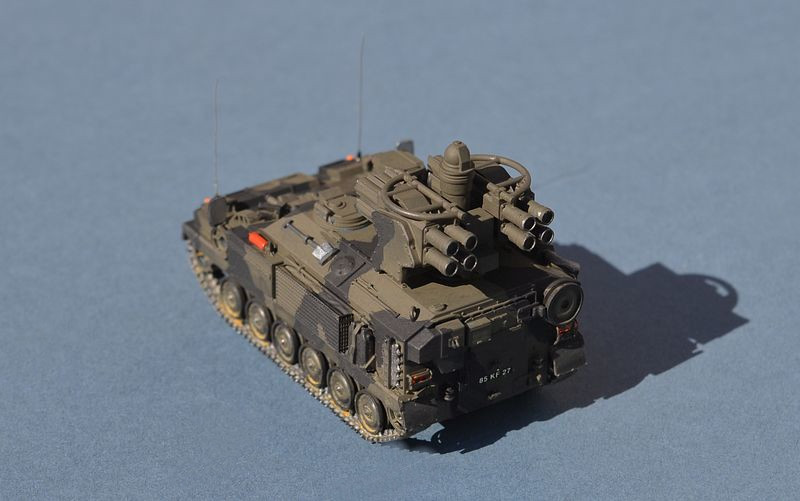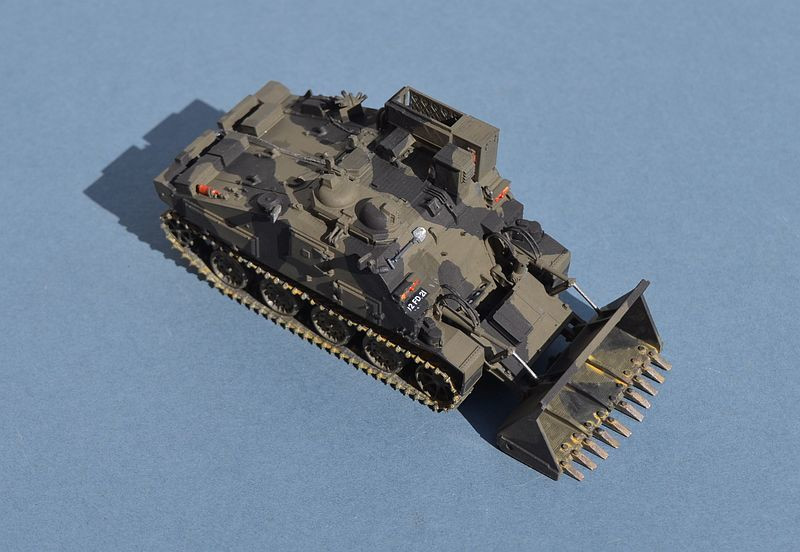December 2024 Part 2
Alvis Stormer HVM
Combat Engineer tractor
Thales Hawkei PMV
M142 HIMARS
FV 4333 Alvis Stormer HVM
British Army, 2020
Osiris / Badger 3D 1/72
The Alvis Stormer was a development of the widely used Alvis CVR(T) that included the Scorpion, Scimitar, Samaritan and Spartan amongst others. Slightly larger, with an extra road wheel,on each side, it was subsequently chosen as the base for the mobile short range air defence (SHORAD) High Velocity Missile system (HVM) .
The HVM system was originally based around the Thales Starstreak missile, a laser guided weapon that has proved highly successful in Ukraine. Available in dismounted and vehicle versions, when carried by a Stormer, it uses an automated alerting system to initiate an engagement. Flying at up to Mach 4, it is almost impervious to countermeasures and strikes the target wit 3 separate guided tungston darts fitted with a small warhead.
More recently, HVM units have been adapted to enable use of the less sophisticated and much cheaper Thales “Martlet” Lightweight Multirole Missile (LMM) which is also carried as an ASuW weapon by RN Wildcat helicopters and will become one of the payloads carried by future Arrmy rocket artillery. Martlet missiles have been donated to Ukraine and once again have proved highly effective when used from Stormer HVM vehicles or as a man portable system.
This page wraps up a number of miscellaneous builds that I have undertaken during the year as side projects to fill in time alongside my other kit builds. All except the HIMARS are 3D printed models, something entirely new to me, and I have been much impressed. These were purchased online from Osiris Models at what I consider a reasonable price. Painting was my usual Humbrol enamels. Apart from adding a few cables to the CET, redoing the HIMARS launcher hinges and painting all of them, what you see is what arrives in the mail!
Of course, not having to build the model does remove a big part of the fun and I can’t see them fully replacing plastic construction kits, but the quality of these 3D prints is superb and I suspect it could render traditional resin moulded accessory parts as largely obsolete.



FV 180 Combat Engineer Tractor (CET)
Royal Engineers, British Army, 1978
Osiris / Badger 3D 1/72
The CET was developed in early 1960s, as an armoured, amphibious earth mover for use on the battlefield. Manufactured by the Royal Ordnance Factory at Leeds and Nottingham, production commenced in 1977, with the first vehicles being delivered to the Royal Engineers in 1978, with additional examples bought by India and Singapore.
Manned by a crew of two -
The CET can wade to a depth of 1.8m without preparation, but can be made fully amphibious by fitting a flotation bag to the excavator bucket and a 'washboard' to the front hull.



Thales Hawkei Protected Mobility Vehicle (PMV)
Speculative British Army markings -
Osiris 1/72
The Hawkei is an Australian developed light Mine Resistant Armoured Patrol Vehicle
(MRAP) developed specifically for the Austrailian Army that has been offered to a
number of other nations as a potential replacement for legacy patrol and MRAP vehicles.
At 7 tonnes, it is capable of being lifted by a Chinook helicopter and fits easily
inside a C-
Named after the Hawkei snake, which in turn was named after ex Austrialian premier
Bob Hawke, its main competition has been the US Joint Light Tactical Vehicle produced
by Oshkosk (L-
Thales UK offered a combination of the Bushmaster and Hawkei for the British Army’s Land Mobility Programme Light Protected Mobility category, as a possible replacement for the Stormer HVM, and FV430 Bulldog APC, as well as the Iveco LMV (Panther) and Foxhound, both of which replaced the infamous “Snatch” Land Rover.
Unfortunately the Land Mobility Programme was suspended / cancelled in 2021 and it is not clear whether or when it will be reinstated.
Background Image -
M142 High Mobility Artillery Rocket System (HIMARS)
US Marine Corps -
Dragon 1/72
HIMARS has proved to be the most valuable weapons system of the Ukrainian / Russian conflict so far. Used snce 2005 by the USMC and US Army, it is a lightweight version of the widely used M270 GMLRS guided artillery missile system, replacing the earlier tracked launch vehicle with a (relatively) lightweight truck based on the US Army’s FMTV M1140 medium truck series. Initial HIMARS vehicles used unarmoured basic FMTV truck versions, but more recently the vehicles have been equipped with armoured cabs.
The missile system itself uses the same modules as the tracked M270 launcher and can carry a single pod of 6 GMLRS (the M270 carries 2) or a single ATCMS conventionally armed tactical ballistic missile. Missile pods are visually identical to prevent observers determining whether GMLRS or ATACMS are carried. A wide range of missile types can be loaded in the 6 round pods, mostly differing in warhead type, but with a general range of around 50 miles, although an extended version with a 90+ mile range is also available. The single ATACMS pod also has a variety of potential rounds, with ranges up to around 185 miles. The system is subject to some controversy as it replaced that Lance tactical nuclear delivery system, although the US Congress specifically forbid any development of HIMARS nuclear capability by the US in 1984. Nevertheless, its export to non US users has been the subject of much scrutiny.
The USMC have demonstated an ability to fire HIMARS from a ship at sea and it has also been tested as an anti aircraft missile launcher equipped with AMRAAM missiles.
An undisclosed number of systems (but probably around 40) were supplied to Ukraine in 2022 and despite being one of the Russian’s highest priority targets, none were destroyed until early in 2024.



Below -





